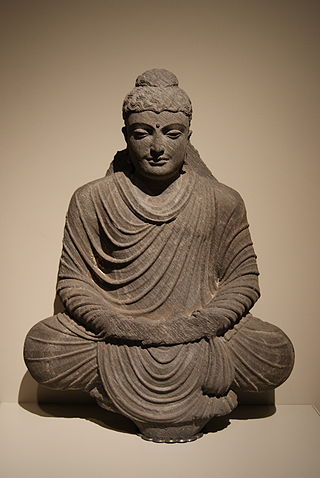
The Noble Eightfold Path or Eight Right Paths is an early summary of the path of Buddhist practices leading to liberation from samsara, the painful cycle of rebirth, in the form of nirvana.

Ānāpānasati, meaning "mindfulness of breathing", is the act of paying attention to the breath. It is the quintessential form of Buddhist meditation, attributed to Gautama Buddha, and described in several suttas, most notably the Ānāpānasati Sutta.
Satipatthana is a central practice in the Buddha's teachings, meaning "the establishment of mindfulness" or "presence of mindfulness", or alternatively "foundations of mindfulness", aiding the development of a wholesome state of mind. In Theravada Buddhism, applying mindful attention to four domains, the body, feelings, the mind, and key principles or categories of the Buddha's teaching (dhammās), is thought to aid the elimination of the five hindrances and the development of the seven aspects of wakefulness.
In the Buddhist tradition, the five hindrances are identified as mental factors that hinder progress in meditation and in daily life. In the Theravada tradition, these factors are identified specifically as obstacles to the jhānas within meditation practice. Within the Mahayana tradition, the five hindrances are identified as obstacles to samatha (tranquility) meditation. Contemporary Insight Meditation teachers identify the five hindrances as obstacles to mindfulness meditation.

Buddhist meditation is the practice of meditation in Buddhism. The closest words for meditation in the classical languages of Buddhism are bhāvanā and jhāna/dhyāna.

In Buddhism, the Seven Factors of Awakening are:
In Buddhism, dhamma vicaya has been variously translated as the "analysis of qualities," "discrimination of dhammas," "discrimination of states," "investigation of doctrine," and "searching the Truth." The meaning is ambivalent; it implies the investigation of the Buddhist teachings (dhamma), but also the application of discernment to body-mind phenomena in order to apply right effort, giving way to entry into the first jhana.
Sati, literally "memory" or "retention", commonly translated as mindfulness, "to remember to observe", is an essential part of Buddhist practice. It has the related meanings of calling to mind the wholesome dhammas such as the four establishments of mindfulness, the five faculties, the five powers, the seven awakening-factors, the Noble Eightfold Path, and the attainment of insight, and the actual practice of maintaining a lucid awareness of the dhammas of bodily and mental phenomena, in order to counter the arising of unwholesome states, and to develop wholesome states. It is the first factor of the Seven Factors of Enlightenment. "Correct" or "right" mindfulness is the seventh element of the Noble Eightfold Path.
Anussati means "recollection," "contemplation," "remembrance," "meditation", and "mindfulness". It refers to specific Buddhist meditational or devotional practices, such as recollecting the sublime qualities of the Buddha, which lead to mental tranquillity and abiding joy. In various contexts, the Pali literature and Sanskrit Mahayana sutras emphasise and identify different enumerations of recollections.

The Ānāpānasati Sutta (Pāli) or Ānāpānasmṛti Sūtra (Sanskrit), "Breath-Mindfulness Discourse," Majjhima Nikaya 118, is a discourse that details the Buddha's instruction on using awareness of the breath (anapana) as an initial focus for meditation.

The Dhammacakkappavattana Sutta is a Buddhist scripture that is considered by Buddhists to be a record of the first sermon given by Gautama Buddha, the Sermon in the Deer Park at Sarnath. The main topic of this sutta is the Four Noble Truths, which refer to and express the basic orientation of Buddhism in a formulaic expression. This sutta also refers to the Buddhist concepts of the Middle Way, impermanence, and dependent origination.
Paṭik(k)ūlamanasikāra is a Pāli term that is generally translated as "reflections on repulsiveness". It refers to a traditional Buddhist meditation whereby thirty-one parts of the body are contemplated in a variety of ways. In addition to developing sati (mindfulness) and samādhi (concentration), this form of meditation is considered conducive to overcoming desire and lust. Along with cemetery contemplations such as the contemplation of the nine stages of decay, this type of meditation is one of the two meditations on "the foul" or "unattractive".
In Buddhism, a mental fetter, chain or bond shackles a sentient being to saṃsāra, the cycle of lives with dukkha. By cutting through all fetters, one attains nibbāna.
Sampajañña is a term of central importance for meditative practice in all Buddhist traditions. It refers to "The mental process by which one continuously monitors one's own body and mind. In the practice of śamatha, its principal function is to note the occurrence of laxity and excitation." It is very often found in the pair 'mindfulness and introspection' or 'mindfulness and clear comprehension).

In the oldest texts of Buddhism, dhyāna or jhāna is a component of the training of the mind (bhavana), commonly translated as meditation, to withdraw the mind from the automatic responses to sense-impressions and "burn up" the defilements, leading to a "state of perfect equanimity and awareness (upekkhā-sati-parisuddhi)." Dhyāna may have been the core practice of pre-sectarian Buddhism, in combination with several related practices which together lead to perfected mindfulness and detachment.
Samatha, "calm," "serenity," "tranquility of awareness," and vipassanā, literally "special, super, seeing ", are two qualities of the mind developed in tandem in Buddhist practice.
The Buddhist path (marga) to liberation, also referred to as awakening, is described in a wide variety of ways. The classical one is the Noble Eightfold Path, which is only one of several summaries presented in the Sutta Pitaka. A number of other paths to liberation exist within various Buddhist traditions and theology.

Bhante Vimalaraṁsi was an American Buddhist monk and Abbot of the Dhamma Sukha Meditation Center in Annapolis, Missouri.
Early Buddhist texts (EBTs), early Buddhist literature or early Buddhist discourses are parallel texts shared by the early Buddhist schools. The most widely studied EBT material are the first four Pali Nikayas, as well as the corresponding Chinese Āgamas. However, some scholars have also pointed out that some Vinaya material, like the Patimokkhas of the different Buddhist schools, as well as some material from the earliest Abhidharma texts could also be quite early.
Kumashpur, also spelled Kumaspur and Kumaspura, is a village within Municipal Corporation of Sonipat in Sonipat district of Haryana state in India. It is 11 km from Sonipat Junction railway station, 45 km from Maharana Pratap Inter State Bus Terminus at Kashmiri Gate, Delhi, and 190 km from Chandigarh on NH1 Grand Trunk Road.









